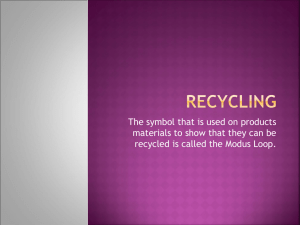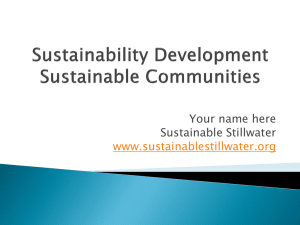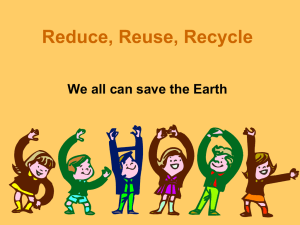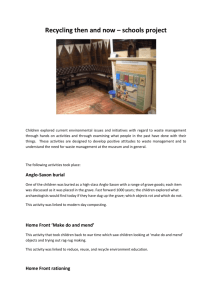KUTZTOWN UNIVERSITY ELEMENTARY EDUCATION
advertisement
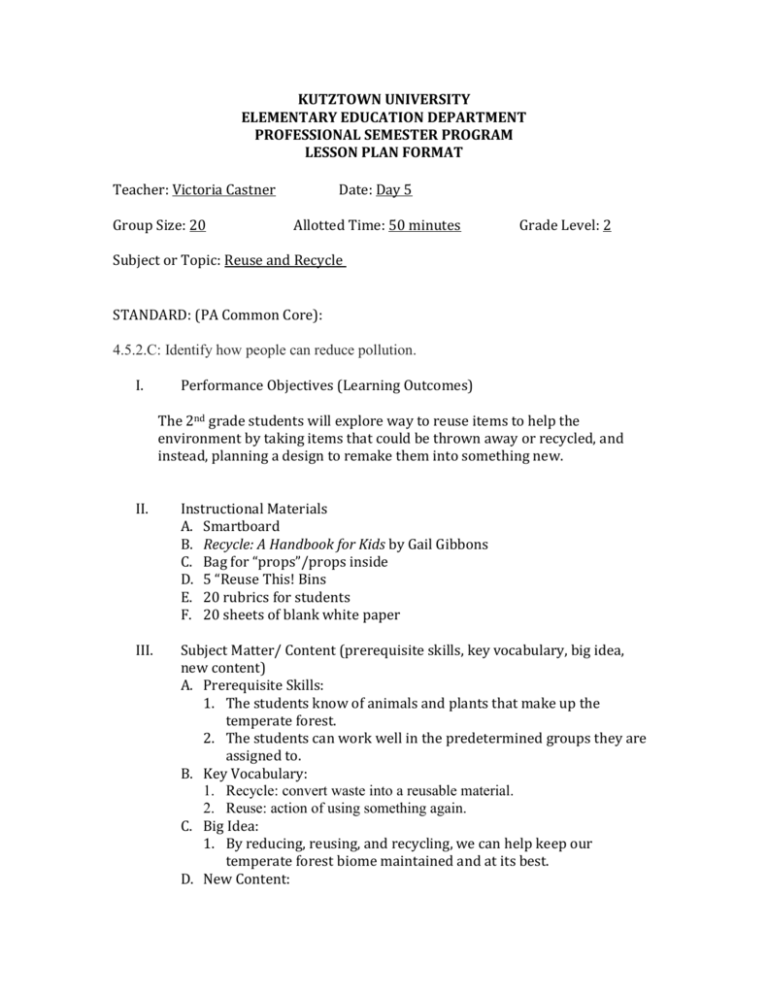
KUTZTOWN UNIVERSITY ELEMENTARY EDUCATION DEPARTMENT PROFESSIONAL SEMESTER PROGRAM LESSON PLAN FORMAT Teacher: Victoria Castner Group Size: 20 Date: Day 5 Allotted Time: 50 minutes Grade Level: 2 Subject or Topic: Reuse and Recycle STANDARD: (PA Common Core): 4.5.2.C: Identify how people can reduce pollution. I. Performance Objectives (Learning Outcomes) The 2nd grade students will explore way to reuse items to help the environment by taking items that could be thrown away or recycled, and instead, planning a design to remake them into something new. II. Instructional Materials A. Smartboard B. Recycle: A Handbook for Kids by Gail Gibbons C. Bag for “props”/props inside D. 5 “Reuse This! Bins E. 20 rubrics for students F. 20 sheets of blank white paper III. Subject Matter/ Content (prerequisite skills, key vocabulary, big idea, new content) A. Prerequisite Skills: 1. The students know of animals and plants that make up the temperate forest. 2. The students can work well in the predetermined groups they are assigned to. B. Key Vocabulary: 1. Recycle: convert waste into a reusable material. 2. Reuse: action of using something again. C. Big Idea: 1. By reducing, reusing, and recycling, we can help keep our temperate forest biome maintained and at its best. D. New Content: Items can be recycled into 4 groups. These groups are paper, plastic, metal and glass. Items can also be reused. This means taking something like a water bottle and refilling it or using it as something new, such as part of a craft. Items can be reduced if we use less of them. For example, we can use a lunch box instead of brown bags everyday. IV. Implementation A. Introduction – 1. The teacher will pull out a grab bag. Inside the bag will be a recycling symbol, a can, a water bottle, a glass Snapple bottle, and a worksheet. The teacher will ask the students to turn and talk with their tables about what these items have in common. 2. The students will turn and talk. 3. The teacher will call on students to share ideas. 4. The teacher will say the right answer is that all these items can be recycled. “Today we are going to learn about what it means to recycle, and why recycling can help make the temperate forest the best it can be!” B. Development – 1. The teacher will hold up all the items in her bag and say, “Talk with your tables. What do you think could happen if all these items were littered outside in a place like the temperate forest?” 2. The students will turn and talk. 3. The students will share ideas and the teacher will list them on the smartboard. a. Ideas should include, the animals like birds, could eat these instead of the foods they need, hurt or kill animals, smother plants, start fires, attract rats and bacteria, ect. The teacher will add to the list as needed to hit those key ideas. 4. The teacher will read the book, Recycle! A Handbook for Kids, by Gail Gibbons. This book teaches about sorting recyclables and the process they go through. 5. The teacher will say today, we are going to practice the three R’s. Reduce, reuse, recycle. The teacher will explain that reduce means to use less. So for example, using a lunch box instead of throwing away a brown bag everyday. Reuse means to use something again. An example could be taking a water bottle and using it again or using it for something brand new, such as a part of a craft. 6. The teacher will give each child a “Reuse this!” bin. There will be 5 groups, each with 4 students. The groups have been predetermined. The teacher will explain that everyone is being graded on this project. She will hand out the rubric and explain it after giving the directions. In the bin will be recycled objects, such as water bottles, cans, cereal boxes, shoe boxes, mason jars, plastic containers, ect. There will also be craft supplies such as crayons, markers, glue, scissors, pom-poms, sequins, heavy tape, ect. The teacher will also give each student a piece of blank paper to sketch his or her ideas onto. 7. The teacher will explain the directions. “With your groups, you are to first explore the items in your bins. Then you must work together to come up with an idea to use some of these products. For example, I could cut this cereal box open, decorate it to make sure I use at least one of each material, and tape the outside border to turn it into a place for students to turn papers into. Once you have an idea, each member must sketch it out as a plan. Your sketch must include labels. I will approve your idea, and then you can get to work on creating it!” 8. The students will work with their groups to create and sketch ideas. 9. The teacher will circulate monitoring progress and scaffolding as needed. 10. All students will create something new, reusing the materials in their bins. C. Closure – 1. The teacher will ask each group to share. 2. The groups will come up one at a time to show the class their new creations. 3. The teacher will ask, “Turn and talk with a partner about why it is important to reuse and recycle materials, instead of throwing them away.” 4. The teacher will share on a student to say that recycling reduces the harmful effects on our environment. The teacher will use this as a whole group discussion to clarify understanding if necessary. The teacher will also explain that we can do this at home, and reuse things instead of throwing them away. 5. The students will bring up their bins and creations and turn in their idea sheet. D. Accommodations / Differentiation – 1. Students will be discussing in small groups and whole group through out the lesson. 2. The students will be creating something new hands on. 3. To accommodate a student with Autism, the teacher will make that child a checklist/schedule for the lesson. It will read: a. Grab bag b. Teacher will read a recycle book c. Brainstorm, sketch and label creation idea d. Draw creation idea e. Make your creation f. Share with the class g. Class talk h. Clean up E. Assessment/Evaluation plan 1. Formativea. The teacher will use a checklist. Each student will earn “Complete” or “Incomplete” on drawing out their ideas. The teacher will also mark “Participating” or “Not Participating” for the day. The student must be talking with and contributing within their group to earn participating. 2. Summativea. There is no summative evaluation for this lesson. b. At the end of the unit, students will complete a unit test. 3. Performance Assessment: The students will be assessed on their performance of the day using the following rubric: Material Design Use of Materials Presentation Awesome Job! Good Effort 3 Student has planned, and sketched with labels for their work ahead of time. Students used all 4 types of recyclables to create their new design! 2 Student has planned and sketched, but without labels. Student spoke clearly, made eye contact, was and was loud. Students used 2-3 different types of materials to create their design. Student spoke, but was missing one of the key elements (clear, eye contact, loud) Needs Improvement 1 Student has only orally planned and has no sketch. Incomplete Students used 1 material type to create their design. Students did not use any materials and did not create a new design. Student spoke but was missing two of the key elements (clear, eye contact, loud) Student did not speak during group presentation. 0 Student has not planned at all before starting to use materials. V. Reflective Response A. Report of Students’ Performance in Terms of States Objectives (Reflection on students performance written after lesson is taught, includes remediation for students who failed to meet acceptable level of achievement) 1. Report of Student Performance: 2. Remediation Plan: Students who are not participating in the activity will be asked to stay inside during recess. These students will be given another bin to try again. The teacher will assist these students as needed to guide them. B. Personal Reflection (Questions written before lesson is taught.)(Reflective answers to questions recorded after lesson is taught.) 1. Was I able to keep the class under control? 2. Was I able to answer any questions the students had to give them a further explanation if needed? VI. Resources Gibbons, G. (1992). Recycle!: A handbook for kids. Boston: Little, Brown. Name_______________________________ Date_____________ Directions: With your group, you will use materials from your “Reuse This!” bins to create something new from recycled goods. Please use at least one material from each category, (paper, plastic, glass, metal). You must sketch your design and have it teacher approved before you begin building! We will be presenting these at the end of class today. Material Design Use of Materials Presentation Score: ____/9 Awesome Job! Good Effort 3 Student has planned, and sketched with labels for their work ahead of time. Students used all 4 types of recyclables to create their new design! 2 Student has planned and sketched, but without labels. Student spoke clearly, made eye contact, was and was loud. Students used 2-3 different types of materials to create their design. Student spoke, but was missing one of the key elements (clear, eye contact, loud) Needs Improvement 1 Student has only orally planned and has no sketch. Incomplete Students used 1 material type to create their design. Students did not use any materials and did not create a new design. Student spoke but was missing two of the key elements (clear, eye contact, loud) Student did not speak during group presentation. 0 Student has not planned at all before starting to use materials.



